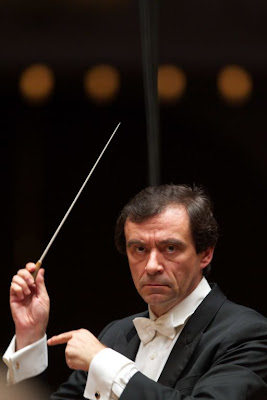Obecní dům
October 20
Dramaturgists labor to construct concert programs that fit neatly together, but sometimes counterintuitive programming can be the most interesting. In February, the Prague Symphony Orchestra did a night that seemed beyond black-and-white: Mozart’s Sinfonia concertante for wind quartet and chamber orchestra (K 297b) in the first half, and Shostakovich’s Symphony No. 7 (“Leningrad”) in the second. It was a revelation, a lesson in how two seemingly disparate works can complement and illuminate each other – and an evening of great music.
 |
| Rota, a romantic at heart. |
On a slightly lesser scale, the Czech National Symphony Orchestra offered a similarly contrasting program last night: Italian romantic music in the first half, and Stravinsky’s Rite of Spring in the second. The weight was perhaps too disproportionate, especially with conductor Marcello Rota impressively fluent in the Italian repertoire, but less well-versed in 20th-century fare. Still, the pairing was refreshing, and the audience loved it.
The program opened with a Clarinet Concerto in B flat major by Saverio Mercadante, an acolyte and contemporary of Rossini. Though he’s considered a minor composer now, Mercadante churned out a remarkable amount of popular music in his day, including more than 50 operas. Some of his chamber works have been revived, and the clarinet concerto was a nice choice, a playful, quick-witted piece that gave soloist Giampiero Sobrino a chance to show off his dexterity. The piece gets faster and increasingly complicated as it develops, until by the end the composer seems to be daring the soloist: “Let’s see you play this.” Sobrino met the challenge nicely.
Since Mercadante laid some of the groundwork for Verdi, a piece by the latter was a logical follow-up, though the overture to Verdi’s Macbeth was perhaps not the best choice. The portentous, dramatic tone of the music and big blasts of brass came as a shock after the light-hearted fun of the clarinet runs. And because the overture is so brief, it seemed more like a wake-up call for anyone who had nodded off during Mercadante.
 |
| Great dexterity from soloist Sobrino. |
The first half concluded with selections from the Rossini operas Moses in Egypt and The Lady of the Lake, atypical choices that once again gave Sobrino a chance to demonstrate his considerable skills. Rota kept the orchestra muted to showcase the soloist, who had more lead work this time, and proved adept not only with developing lines, but a final flourish that could have been lifted from a 1940s swing band. Sobrino also showed nice range on his encore, a waltz from Rigoletto.
Is it possible to hear The Rite of Spring too many times? Not for this reviewer, who finds something new to discover every time out. Last night it was the textures in the second half, which still sound as innovative and fresh as shoots in the titular season. Rota was best with those and the dramatic, crashing chords; otherwise, he didn’t bring much imagination to the piece, nor great definition.
Overall, the program was an accurate reflection of the orchestra’s greatest strength, its versatility. While not in the category of, say, the Czech Philharmonic, the CNSO stays busy on every front – performing, touring, recording CDs and film scores, and backing big-name singers like Andrea Bocelli. Founder, director and trumpet player Jan Hasenöhrl has also proven to be a marketing genius with his summer Prague Proms series, which packs Obecní dům at a time of year when it was once thought impossible.
Besides, you have to love any orchestra that includes this one-liner on the opening page of its program: “Thank you for withholding applause between movements.”
No comments:
Post a Comment